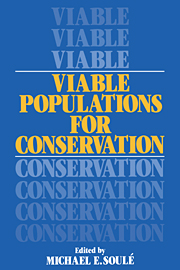Book contents
- Frontmatter
- Contents
- List of contributors
- Preface
- 1 Introduction
- 2 The demography of chance extinction
- 3 Extinction models and mammalian persistence
- 4 Minimum viable population size in the presence of catastrophes
- 5 Minimum viable populations: coping with uncertainty
- 6 Effective population size, genetic variation, and their use in population management
- 7 Spatial structure and population vulnerability
- 8 Managing critically endangered species: the Sumatran rhino as a case study
- 9 The role of interagency cooperation in managing for viable populations
- 10 Where do we go from here?
- Index
7 - Spatial structure and population vulnerability
Published online by Cambridge University Press: 21 January 2010
- Frontmatter
- Contents
- List of contributors
- Preface
- 1 Introduction
- 2 The demography of chance extinction
- 3 Extinction models and mammalian persistence
- 4 Minimum viable population size in the presence of catastrophes
- 5 Minimum viable populations: coping with uncertainty
- 6 Effective population size, genetic variation, and their use in population management
- 7 Spatial structure and population vulnerability
- 8 Managing critically endangered species: the Sumatran rhino as a case study
- 9 The role of interagency cooperation in managing for viable populations
- 10 Where do we go from here?
- Index
Summary
Population extinction can result from many factors. Even though most cases are hidden from observers, its processes can be viewed in different ways. The other chapters of this book focus on single features of species biology that contribute to species extinction. Superficially, this chapter treats yet another factor: the extension of the spatial stage on which the extinction drama is played. Nonetheless, space is something different. It affects and is, in turn, affected by the other aspects of species biology that contribute to extinction.
The spatial extension of ecological systems, which considers the actual locations of organisms in the landscape, is not routinely incorporated into theoretical formulations of population genetics, demography, population dynamics, and community ecology. Our theories typically present variables such as N's and p's that summarize, with a single number, the ecological and genetical states of a system over some conceptually delimited region of physical space. That is, N is a count of all the animals in this space; it does not tell where they are, or how they are clumped or otherwise associated. Similarly, p represents a gene frequency in a ‘population’ of organisms, but the region over which this estimate is valid is not normally specified.
This reluctance to address questions of spatial extension results from at least two important considerations.
- Type
- Chapter
- Information
- Viable Populations for Conservation , pp. 125 - 140Publisher: Cambridge University PressPrint publication year: 1987
- 87
- Cited by



